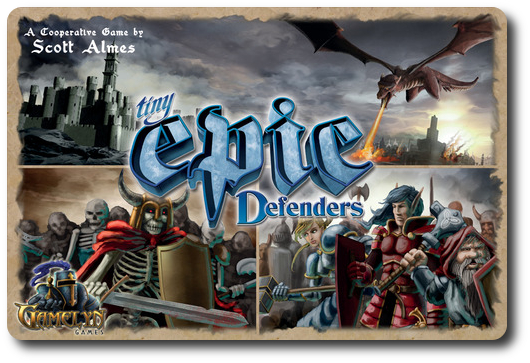
The Basics:
- For ages 7 and up (publisher suggests 8+)
- For 1 to 4 players
- Approximately 30 minutes to complete
Geek Skills:
- Active Listening & Communication
- Counting & Math
- Logical & Critical Decision Making
- Reading
- Strategy & Tactics
- Risk vs. Reward
- Cooperative & Team Play
- Hand/Resource Management
- Worker Placement & Area Control
Learning Curve:
- Child – Easy
- Adult – Easy
Theme & Narrative:
- Only by working together can you protect the kingdom from certain doom!
Endorsements:
- Gamer Geek approved!
- Parent Geek approved!
- Child Geek approved!
Overview
After the Great War, the land and its people were broken. From the ashes arose a new ideal and hope. The surviving races would gather and build a great city where all could live in peace. In less time than it took to destroy the kingdom, a new one was born. At its center was the Capital City which stood like a beacon to guide the lost. But beyond the border of the newly healed lands, something festered. Darkness looked upon the kingdom and felt hate in its heart.
Tiny Epic Defenders, designed by Scott Almes and published by Gamelyn Games, is comprised of 7 Region cards, 6 Epic Foe cards, 10 Hero cards, 4 Ally cards, 2 Group Ally cards, 6 Dire Enemy cards, 9 Enemy cards, 10 Artifact cards, 4 Hero meeples (in 4 different colors), 4 Hero Health tokens (in 4 different colors), 7 Region Threat tokens, and 1 Epic Foe Health token. The cards are as thick and as durable as your standard playing card and the meeples and tokens are made of painted wood. For such a small game, the component quality is excellent.
Tiny Epic Defenders is part of the “Tiny Epic” family line of games. The first game in the line was Tiny Epic Kingdoms that pitted players against each other in a race to take over regions using light 4X (eXplore, eXpand, eXploit, and eXterminate) game play. Tiny Epic Defenders thematically takes place after the “Great War” depicted in Tiny Epic Kingdoms and shifts from being a game about conquering to a game about defending. The players will be working as a team to defend the land against a common foe.
The Dawning of a New Kingdom
To set up the game, first give each player 1 Hero card. This can be done randomly or you can allow players to discuss which Hero cards should be selected to maximize team effectiveness and synergy. Players place their selected Hero card in front of them, face-up. Any Hero cards not selected are returned to the game box.
Second, take the Region cards and decide which sides to use. The different sides provide different abilities, but one side is not designed to be more difficult from the other. Place the “Capital City” Region card in the middle of the playing area. Place the remaining 6 Region cards around the “Capital City” Region card in a circle formation. If the players want to play a game with a difficulty of “hard” or “epic”, place the regions around the “Capital City” at random. For “easy” and “medium” game difficulty, the players can decide where the regions are placed.
Third, give each player 1 Hero meeple and 1 Hero Health token of the same color. Place the Hero meeple on the “Capital City” Region card and the Hero Health token on the largest Health number on the player’s Hero card.
Fourth, place 1 Region Threat token on the “Capital City” Region card to identify its starting Threat Level is “0”. Place 1 Region Threat token on the remaining 6 Region cards to identify its starting Threat Level as “1”.
Fifth, shuffle the Epic Foe cards and randomly select 1, placing it face-down above the Region cards. Place the Epic Foe Health token next to the Epic Foe card. Place the remaining Epic Foe cards back in the box without looking at them.
Sixth, create the Turn, Horde, and Destruction decks. This step is difficult to describe without using a visual aid. Refer to the following hastily created image, if you please.
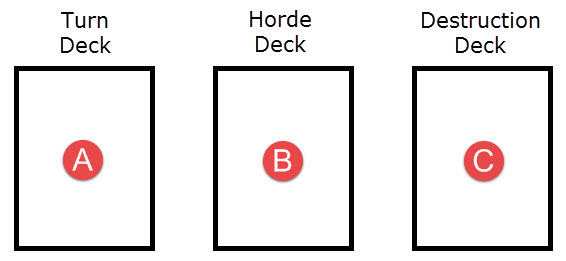
- Take the Enemy cards and shuffle them. Deal 3 Enemy cards face-down to start the Turn deck (A), 3 to start the Horde deck (B), and 3 to start the Destruction deck (C).
- Take the Dire Enemy cards and shuffle them. Depending on the level of difficulty selected by the group, deal 1 to 4 Dire Enemy cards face-down to the Horde deck (B). All remaining Dire Enemy cards are placed face-down in the Destruction deck (C).
- Take 1 Ally card for each player in the game, making sure the Ally card color matches a player’s meeple color. Place the Ally cards face-down on the Turn deck (A). All remaining Ally cards are placed face-down in the Destruction deck (C).
- If playing with 1 to 2 players, add both Group Ally cards to the Turn deck (A). If playing with 3 players, add only 1 Group Ally card. If playing with 4 players, no Group Ally cards are used. All remaining Group Ally cards are placed face-down in the Destruction deck (C).
- Shuffle the Turn deck (A), placing it face-down and within easy reach of at least 1 player.
- Shuffle the Horde deck (B) and place it face-down on top of the Epic Foe card.
- Take the Destruction deck (C)) and place it to one side of the gaming area. It will be used later in the game when things start going badly for the players.
Seventh, take the Artifact cards and shuffle them. Place the Artifact deck next to the Turn deck, face-down.
That’s it for game set up. Time to save the Kingdom!
The Land, the Heroes, and the Evil Beyond the Borders
The Capital and Its Surrounding Territories
At the heart of the new kingdom lies the Capital City. Here monuments to heroes of the past tower above cobbled streets and the different races of the realm live in peace. It’s also the seat of government, where the outlying regions send delegates. In many respects, the Capital City is the heart and soul of the kingdom, which is why it’s the target for the enemies that are attacking. If the Capital City should fall, the players have lost the game.
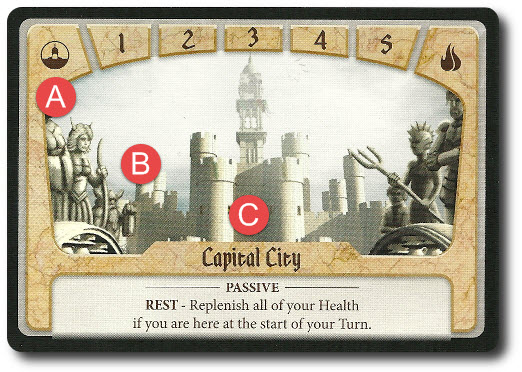
A) Capital City Threat Level track
B) Location for meeples
C) Name of region and description of ability
Surrounding the “Capital City” Region card are the 6 outer Region cards. These regions will be attacked over and over again during the game, forcing the players to come to their aid and put down the threat. Like the “Capital City” Region card, each of the 6 regions have their own special ability. It will be up to the players to determine how best to use them to win the day.
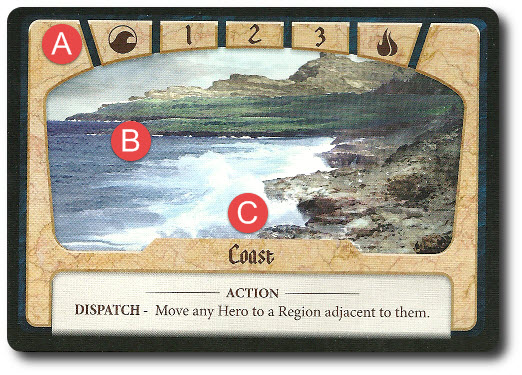
A) Region symbol and Threat Level track
B) Location for meeples
C) Name of region and description of ability
The Heroes
Each player is provided a Hero card at the start of the game. The Hero card gives the player all they need to jump into the game, including the hero’s health and special abilities. There are 10 different heroes in the game and each is unique. Hereos can only use their abilities on their turn, but not all abilities will tax the hero’s strength. “Passive” abilities can be used without cost, but “action” abilities will reduce the number of actions the player can take.
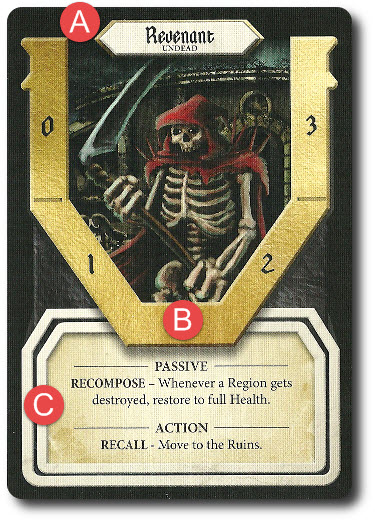
A) The name of the Hero and their race
B) The Hero Health track (the Hero Health token is placed here)
C) The Hero’s abilities
The Enemy
Beyond the borders of the 6 regions that surround the Capital City, danger and darkness lurks. Hordes of monsters are gathering and organizing. The Epic Foe is planning a massive assault on the Capital City, but the first order of business is to slowly weaken the defenses of kingdom. The Enemy cards represent small bands of monsters that attack specific regions. Their attacks are not that strong and can be easily defended, but it’s difficult to predict where the strike will come.
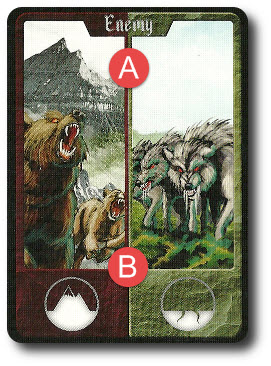
A) Images of the enemies attacking
B) Symbols of the regions being attacked
The Dire Enemy
The Dire Enemy could be considered the officers in the Epic Foe’s army. They are bigger, badder, and most certainly more dangerous. They have abilities like the heroes and do more damage. Like their lesser powered comrades, the Dire Enemy also has a nasty habit of showing up unannounced and most certainly uninvited.
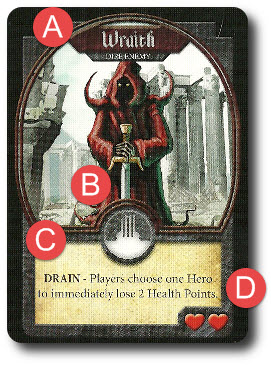
A) Name of Dire Enemy
B) Symbol of the region being attacked
C) The Dire Enemy’s ability
D) The amount of Health the hero loses if they defend against the Dire Enemy’s attack
The Epic Foe
The Epic Foe is the mastermind behind the attacks on the outer regions and the Capital City. The Epic Foe will first attack using their smaller Enemies and then their Dire Enemies. Only when their entire force has been deployed will the Epic Foe join the fight. When it does, there is no turning back. Either the Epic Foe and darkness will win or the Heroes will triumph.
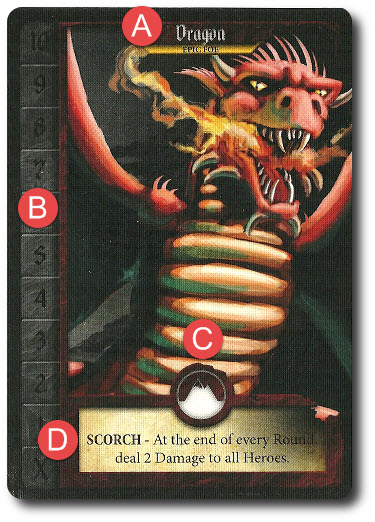
A) Name of the Epic Foe
B) The Epic Foe Health track (the Epic Foe Health token is placed here)
C) The Symbol of the region being attacked
D) The Epic Foe’s ability
Defending the Kingdom
The players are taking on the roles of powerful heroes who have been tasked to defend the kingdom. Each Hero card is affiliated with a specific race and has a unique ability. While this is a cooperative game, players will sometimes find that it’s in their best interest to defend one region versus another. Never to a point where it will create conflict in the game or among players, mind you, but some races tend to have an affinity towards certain regions. As such, players will naturally want to protect those before others. But this is a game about team work and players need to discuss their objectives and devise a workable strategy. Failure to do so will cost the players the kingdom and the game.
Tiny Epic Defenders is played in rounds with no set number of rounds per game. As the game progresses, the threat will increase and become more difficult to manage. Each round will be just a bit more difficult than the last, thematically representing the rising evil that is endangering the land and its people. A typical game round is divided into phases. A typical round is summarized here.
Phase 1: Take Turns
Turns are determined by drawing the top-most card from the Turn deck. There are 4 different card types in the Turn deck meaning that each card drawn could result in 1 of 4 different outcomes. But not at first. The starting Turn deck is pretty light on cards and on threat. As the game progresses, the Turn deck will get larger making it more difficult for the players to keep up and to heal.
Once a card is revealed and resolved, it’s placed face-down in a discard pile next to the Turn deck. Players are not allowed to look through the discard pile.
An Enemy Card is Drawn
At the borders of the kingdom are hordes of nasty creatures that are being driven by some unknown force to attack the borders and weaken the outer regions. Each Enemy card displays 2 symbols. These symbols match the Region cards being attack.
If a Hero meeple is not located on the Region card being attacked, the region’s Threat Level is immediately raised by 1. If a Hero meeple is located on the Region card, the player can reduce their Hero Health value by -1 to “block” the attack from the Enemy card. If 2 or more Hero meeples are in the same region, only 1 player can block the Enemy card attack.
If the region being attacked has a Destruction card on it, unblocked attacks raise the Threat Level of the “Capital City” is instead.
A Dire Enemy Card is Drawn
The Dire Enemy cards represent monsters and foes that are much more threatening than the random roving hordes that are attacking the outer regions. To begin with, the Dire Monster card lists an ability that is triggered when it comes into play.
Players defend against a Dire Enemy’s attack the same way they defend against a weaker Enemy attack, but they sustain more damage by doing so. Anywhere from 2 to 3 points of Health can be lost! Fortunately for all the players, an unblocked Dire Enemy attack on a region only raises the Threat Level by +1, but unblocked attacks on regions with a Destruction card will raise the Threat Level of the “Capital City”.
Defending a region against a Dire Enemy is risky, but it does have its perks. When a player blocks a Dire Enemy’s attack, they get to draw 1 Artifact card. Artifacts are powerful enchanted items. Depending on the Artifact drawn, it can either be used as an action or as a free action. Regardless of when it can be used, the Artifact is discarded once its effects have been resolved.
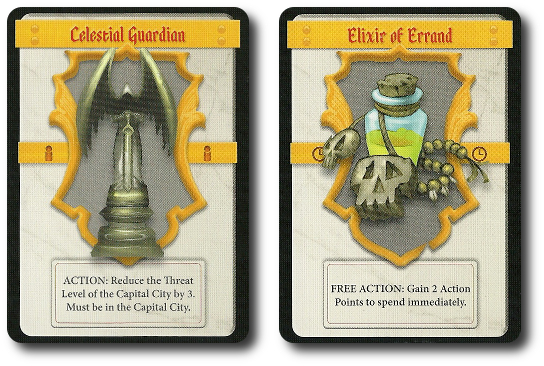
An Ally Card is Drawn
The Ally cards signify which player can have their turn. Each Ally card matches a meeple color. The player who owns that meeple now gets to take their turn and protect the kingdom.
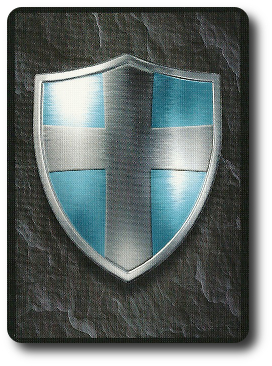
A player can take 3 actions on their turn. Any ability the Hero might have that is identified as an “action” can be used, but only as long as the player hasn’t already used 3 total actions on their turn. “Passive” actions are always considered active and do not reduce the total number of actions the player has on their turn by using.
In most cases, all the following actions are valid. Some Dire Enemies and Epic Foes will change the rules, altering how damage can be inflicted. Additionally, a Hero’s ability or Artifact might provide alternatives or opportunities that would otherwise not be possible. It should also be noted that a Hero does not “die” if their Health is dropped to zero, but they do become far less useful. To heal, a player must take their meeple to the Capital City .
- Move: For 1 action, the Hero meeple can move from 1 Region card to an adjacent Region card.
- Succor: Reduce the Threat Level by 1 in the region where the Hero meeple is currently located. This action cannot be taken if the Hero has zero Health.
- Fight: Reduce the Epic Foe’s Health by 1 if the Hero meeple is located in the same region as the Epic Foe card. This action cannot be taken if the Hero has zero Health.
- Use Region Ability: Use the Region card’s “action” ability if the player’s Hero meeple is located in the same region. A Region card’s ability can be used only once per turn. “Passive” abilities can be used without increasing the total number of actions used during the turn.
- Use Hero’s Ability: If the ability is “active”, it will reduce the total number of total actions the player can take this turn. If the ability is “passive”, it can be used without reducing the total number of actions.
- Use Artifact: Use an Artifact card, resolve its effects, and then discard it.
A Group Ally Card is Drawn
When a Group Ally card is drawn, the players can distribute 3 total actions among as many players as they like. Then the players take their actions. For example, players could decide that 3 players can take 1 action each, or they could decide that 1 player takes 2 actions and the other takes 1 action, or they could decide that 1 player takes all 3 actions. The actions available are the same as those noted above.
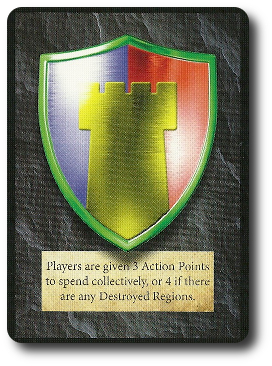
Phase 2: Set for Next Round
After all the Turn cards have been drawn, the top-most Horde card is drawn and placed on the Turn discard pile, face-down. The Turn discard pile is then shuffled and placed face-down.
If there are no cards left in the Horde deck to add to the Turn deck, the Epic Foe reveals themselves!
Losing Regions
As the game progresses, and if the players are unable to or unwilling to reduce a Region card’s Threat Level, it will eventually be lost. A region that has maximized its threat is “destroyed”. A card is drawn from the Destruction deck and placed over the Region card, face-down. The Threat Level in this region can no longer be reduced as the region is completely overrun by the enemy. Even worse, any attacks to this region that are not blocked impact the Threat Level of the “Capital City” Region card. As such, it behooves players to keep a careful eye on their border as they act as shields that protect their kingdom from falling.
Your True Enemy Revealed!
The enemies that have been plaguing the land were just a precursor to the monstrosity that is the Epic Foe. If Enemy cards are nameless monsters and Dire Monster cards are mini-bosses, the Epic Foe is the BIG BOSS that is very much looking forward to smashing the players.
Players must travel to the Region card where the Epic Foe appears. Depending on the Epic Foe, attacking it head on might not be a good idea. While the players figure out how best to destroy the Epic Foe, the Turn deck is still used to determine turn order. Dire Enemies and normal Enemies will still attack the border as a result. The kingdom is now under a full and proper siege!
A Kingdom Saved or a Kingdom Lost?
The players win the day if they defeat the Epic Foe. With the fall of their leader, the evil that is plaguing the land will retreat into darkness. However, the players lose if the Capital City should ever fall. When the city burns, evil has won.
Game Variant
You can play Tiny Epic Defenders as a solitaire game. When doing so, select 2 Hero cards to control and set up the rest of the game as normal, following the guidelines in the game rules. There are no other changes in game play and the conditions for victory or defeat remain the same.
To learn more about Tiny Epic Defenders, visit the game’s web page.
Final Word
The Child Geeks had a wonderful time with this game. We started with the easiest game possible by reducing the number of Dire Enemies. We also hand selected the Epic Foe so as to know exactly what we were up against. This proved to be the right move, as the game was still difficult to win. According to one Child Geek, “You really have to work together as a team or you’ll fail.” Very true. There is simply too much to watch, maintain, and control as a single player. Another Child Geek said, “The only thing I don’t like is the random turns.” This came up a few times during our game playing session. Turns are determined at random and as the game progresses, the length between turns increases, as does the randomness. This is due to the Turn deck getting bigger and bigger throughout the game. It took the Child Geeks awhile to get used to that, but in the end, they rather liked how the game was determining whose turn it was. As one Child Geek put it, “This is a fair game because the monsters have to wait for their turn, too.” I supposed they do. When all the games were over, all the Child Geeks voted to approve Tiny Epic Defenders.
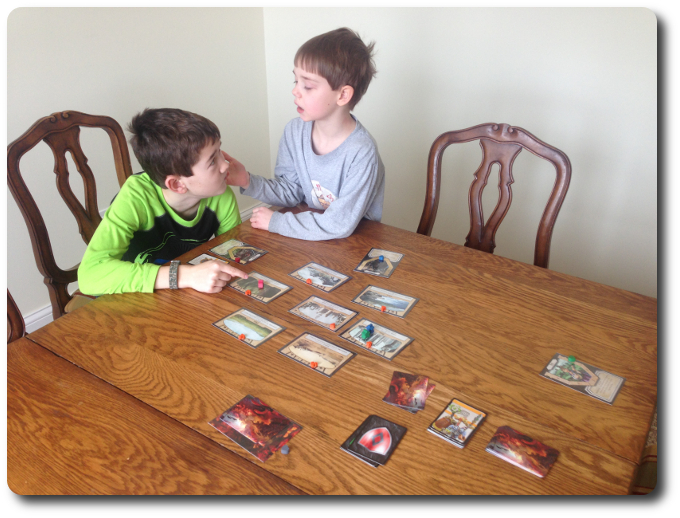
The two brothers discuss how best to save the kingdom…
The Parent Geeks, being familiar with Tiny Epic Kingdoms, really liked the games narrative. One Parent Geek said, “It’s pretty cool how we were all enemies to begin with, but now we are all allies defending against an even greater foe.” All the Parent Geeks found the game play to be intuitive, didn’t care much for the rule book, and found the game to be slightly out of balance at times. As one Parent Geek put it, “Depending on how the Turn cards are drawn, players could all go last, all go first, or somewhere in the middle. That makes it difficult to plan what each player should do and when.” But the Parent Geeks adjusted and found out that they could only ever take actions on their turns, but there was nothing stopping them from discussing, planning, and reevaluating to ensure they always knew what needed their immediate attention. According to one very pleased Parent Geek, “This is an excellent cooperative game. It kept me interested, challenged, and smiling.” All the Parent Geeks voted to approve Tiny Epic Defenders.
The Gamer Geeks were also loving the game. As one Gamer Geek said, “Light and casual, yet challenging and complex at times. You have to watch the game or it will sneak up on you, but never to a point where you can’t see how it will attack you. This is good stuff.” Like the Parent Geeks, the Gamer Geeks didn’t care for the rule book, but found that all their questions were answered once they started playing the game. As one Gamer Geek put it, “Because you randomize everything in this game, it’s never the same game twice. That makes it hard to describe everything in the rule book that could or could not happen in a game, I suppose.” All of the Gamer Geeks were very pleased with the game’s depth, the ability to strategize and tactically address threats, and the ever-shifting game board that kept the players engaged. All the Gamer Geeks voted to approve Tiny Epic Defenders, finding it to be an excellent cooperative game, perfect as a filler or as a light game for their elitist gaming table.
First, let’s address a concern that the Parent and Gamer Geeks had. The rule book in this game is not how I would format it, but it does contain all the information you need to play the game. The problem with the rule book is that the information is not designed in such a way as to make it easy to find specifics. For example, nowhere in the book can you find a summary of the game turn. There is an overview, but nothing that would suggest a sequentially based system of organized play. And here’s why. The game evolves. As the players go about playing, new cards are introduced that change what needs to happen and that change impacts decisions that need to be made. That’s difficult to capture, so the rules are more of an introduction to everything in the game. Not bad, but it did leave new players learning how to play the game a bit bewildered at first. Luckily for everyone, this is an intuitive game and easy to pick up once you are playing it.
Tiny Epic Defenders is a light cooperative that gives the players all the time in the world to talk about what needs to happen next, devise a strategy, and attack the enemy head on. The abilities available from the heroes and the different regions provide opportunities for unique problem solving. The random game set up and card draws keep the player’s guessing, but does give them a clue about what will be attacked again in the future. The growing threat and strength of the Turn deck ramps up the game’s difficulty nicely, with just enough momentum to keep things feeling dangerous.
Not bad for a small game in a small box.
I’ve had a lot of fun with Tiny Epic Defenders. It’s a game I can play with anyone and everyone, including my 5-year-old (although I do most of the playing). Since it’s a cooperative game, you can bring in young and inexperienced players to help out and learn as the game is played. Just make sure you don’t play the game for them. Tiny Epic Defenders tends to bring out the “Commander” in all of us, ordering where players should go and what to tackle first. Keep in mind that this is a cooperative game and everyone must play their part as they think best.
If you like cooperative games that have just enough depth to keep thing interesting, just enough threat to keep things busy, and just enough surprises to keep you guessing, then you’ll find more than enough in Tiny Epic Defenders to make you happy. Do sit down with friends and family to enjoy the challenge of saving this epic tiny kingdom!
This game was given to Father Geek as a review copy. Father Geek was not paid, bribed, wined, dined, or threatened in vain hopes of influencing this review. Such is the statuesque and legendary integrity of Father Geek.




Thank you VERY MUCH for posting this.. I was a KS backer but never looked at the P&P.. I read the rule book.. reread the rule book and reread the rule book.. It actually never mentions that both regions are attacked.. it never clarifies that the symbols = a named region, this isn’t spelled out on BGG either.. I have over 100 games in my library.. and frankly while I thought the components and theme where great.. the rule-book is complete garbage.. I only now after reading your review /play session / spelling it out understand how to play the game.. that’s rubbish.. I hope this gets back to Gamelyn and the fix this by putting a more detailed and complete rule-book online.. I have backed 3 of their games now.. I hope to god the learn from this.
Thanks for taking the time to read the review and leave a comment, Michael.
I am very sorry hear of your frustrations regarding this game. Working through a rule book that isn’t well organized is like trying to take directions from someone who is speaking in a foreign language. I hope our review answered most of your questions. If not, feel free to ask.